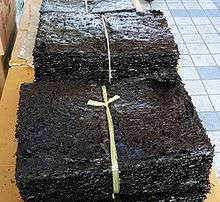Gim (food)
| Gim | |
 gim | |
| Korean name | |
|---|---|
| Hangul | 김 |
| Revised Romanization | gim+ |
| McCune–Reischauer | kim |
Gim (Korean pronunciation: [ɡiːm]; Korean: 김), also spelled as kim,[1] is the Korean word for edible seaweed in the genus Porphyra. It is similar to nori, a Japanese word for this seaweed and used in the production of sushi in Japan. Porphyra is also called laver in English.
History
The earliest mention of gim is recorded in the Samguk Yusa (hangul:삼국유사, hanja:三國遺事) a document created during the Goryeo era documenting the history of the Three Kingdoms Period of Korean history covering 57 BCE to 668. The Samguk Yusa contains passages that record gim having been used as part of the dowry for Shilla royalty. It is conjectured, however, that gim of this period was harvested from rocks and driftwood rather than being cultivated.[2]
From the mid-Joseon period there are records of gim in 15th century documents Gyeongsangdo Jiri Ji(hangul:경상도지리지, hanja: 慶尙道地理誌) and Sinjeung Dongguk Yeoji Seungnam (hangul:신증동국여지승람, hanja:新增東國輿地勝覽). Gim is recorded as a regional delicacy.[3]
Many legends about the etymology of the word gim are given. One version explains that an old lady in the region of Hadong discovered a log covered in gim floating down the Seomjin River, which inspired her to cultivate it on upright bamboo support poles. Another legend says that the word "gim" was named after its creator, Kim Yeo-ik (김여익), who lived in the island Taeindo during the reign of King Injo, who was the first person to have cultivated gim after seeing a drifting oak branch covered in it.[3] Although the true origins of the term are unclear, records dating from the 17th century of Kim Yeo-ik indicate cultivating gim. A monument in Taeindong, Gwangyang, is set up in his honor for these achievements.[4]
Cultivation
As natural collection of gim was not enough to meet demand, various new cultivation techniques developed between the 17th and 19th centuries, mostly in the Gwangyang bay region.[3][5] Although posts and woven frames made from bamboo are traditionally used in cultivation, nets of synthetic fiber are also used in modern times.[5]
Gim is known to grow well in sea water between 5 and 8°C, so gim collection is usually done between December and January. Gim that has been grown for 50 days is considered best for consumption, as the color and flavor are at their best. Cultivation is done mostly in the regions of Jeolla and Gyeongsang, with the gim from Wando being the most famous.[6]
Varieties and nutrition
About ten varieties of gim are grown in Korea. The most common are chamgim (참김, Porphyra tenera) and bangsamuni gim (방사무늬김, Porphyra yezoensis). Others include dungeun gim (둥근김, Porphyra kuniedai), dungeun dolgim (둥근 돌김, Porphyra suborbiculata), and momuni gim (모무늬김, Porphyra seriata).[3][6]
Gim is known to be abundant in protein and vitamins, especially vitamins A, B1, B2, B6, and B12. It is also known to have a high content of mineral salts, particularly iodine and iron, and essential amino acids and properties that dispose of cholesterol, earning its reputation as a "healthy food".[3][6]
Serving
When eaten as a banchan (small side dish), gim is toasted with sesame oil, sprinkled with fine salt and cut into squares. "Gim" is traditionally eaten with rice as a finger food although the use of chop sticks are common. For use in gimbap, the sheets are not roasted and used in its original dried state.[7]
See also
References
- ↑ Abbott, Isabella A (1989). Lembi, Carole A.; Waaland, J. Robert, eds. Algae and human affairs. Cambridge University Press, Phycological Society of America. p. 141. ISBN 978-0-521-32115-0. Food and food products from seaweeds
- ↑ Professor Im Kyungsook. "임경숙 교수의 맛있는 칼럼". VitaminMD. Archived from the original on 2012-03-24.
- 1 2 3 4 5 (Korean) Gim at Encyclopedia of Korean Culture
- ↑ (Korean) 광양김시식지 at Doosan Encyclopedia
- 1 2 (Korean) Gim cultivation at Doosan Encyclopedia
- 1 2 3 (Korean) Gim at Britannica Korea
- ↑ Gim at Korea Tourism Organization